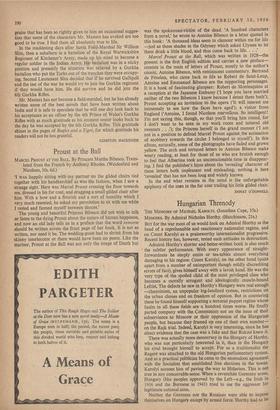Proust at the Ball
'I WAS happily sitting with my partner on the gilded chairs tied together with his handkerchief as was the fashion, when I saw a strange sight. Here was Marcel Proust crossing the floor towards me, dressed in his fur coat, and dragging a small gilded chair after him. With a bow and a flourish and a sort of humility which I very much resented, he asked my permission to sit with me while I rested and fanned myself between dances.'
The young and beautiful Princess Bibesco did not wish to talk or listen to the dying Proust about the nature of human happiness, and now an old lady tells us in a preface that the word remorse should be written across the front page of her book. It is not so written, nor need it be. The wedding-guest had to shrink from his skinny interlocutor or there would have been no poem. Like the mariner, Proust at the Ball was not only the image of Death but was the spokesman-victim of the dead. 'A hundred characters from a novel,' he wrote to Antoine Bibesco in a letter quoted in this book : 'A thousand ideas seem to clamour within me for life —just as those shades in the Odyssey which asked Ulysses to let• them drink a little blood, and thus come back to life. . .
Marcel Proust at the Ball, which was written in 1928—the present is the first English edition and carries a new preface— consists in the main of letters of Proust, mostly to the author's cousin, Antoine Bibesco, with reminiscent commentary. Bertrand de Fenelon, who came back to life as Robert de Saint-Loup, Antoine and Emmanuel Bibesco are the supporting personages. It is a book of fascinating glimpses : Robert de Montesquiou at a reception at the Japanese Embassy ('I hope you have married neither of the two Bibescos I know because I detest them both'); Proust accepting an invitation to the opera ('It will interest me immensely to see how the faces have aged'); a visitor from England ('Antoine, I found Nicolson marvellous. So intelligent! I'm not saying this, though, so that you'll bring him round, for I don't want to be seen in my work room and tattered old sweaters . . .'); the Princess herself in the grand manner ('I am not in a position to defend Marcel Proust against the accusation of snobbery towards the circles I belonged to myself'). In this album, naturally, some of the photographs have faded and grown yellow. The arch and tortured letters to Antoine Bibesco make weary reading, at least for those of us who are brutish enough to feel that Albertine took an unconscionable time in disappear- ing. I find the publisher's hints about the 'revealing' character of these letters both unpleasant and misleading; nothing is here 'revealed' that has not been long and widely known.
In the end what remains in the mind is the unforgettable epiphany of the man in the fur coat trailing his little gilded chair.
PONAT O'DONNELL


































 Previous page
Previous page